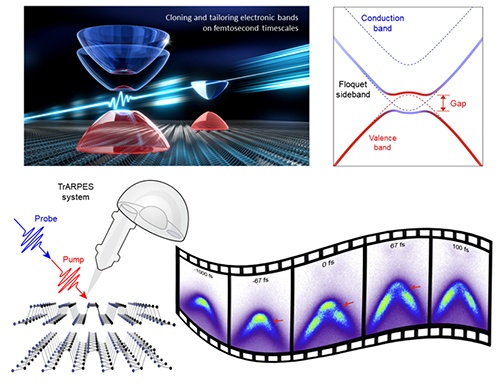
Figure. Realization of light-induced transient manipulation of the electronic structure in black phosphorus via Floquet engineering by TrARPES. (see Nature 614, 75-80 (2023)).
With the support from the National Natural Science Foundation of China (Grant No. 11725418, 12234011, 11427903), a research team led by Prof. Shuyun Zhou from Tsinghua University, in collaboration with Prof. Wenhui Duan and Prof. Pu Yu from Tsinghua University, Prof. Peizhe Tang from Beihang University, and Prof. Sheng Meng from the Institute of Physics, Chinese Academy of Sciences, reported the first experimental realization of light-induced transient manipulation of the electronic structure in a semiconductor – black phosphorus - via Floquet engineering. In addition, it shows strong dependence on the pump polarization, suggesting intriguing coupling with the pseudospin. The research results were published in Nature on February 2, 2023, with the title “Pseudospin-selective Floquet band engineering in black phosphorus”. (Nature 614, 75-80 (2023), full article link at http://www.nature.com/articles/s41586-022-05610-3)
Light-matter interaction plays critical roles in the physics of low-dimensional quantum materials, not only as experimental probes for revealing the underlying physics, but more importantly, as effective control knobs for manipulating the electronic structures and quantum states in the non-equilibrium state, with the fascinating opportunities to induce novel physical phenomena beyond those in the equilibrium state. Capturing the transient electronic structure on the ultrafast timescales (picosecond or even femtosecond, 10-12 or 10-15 seconds) and manipulating their nonequilibrium material properties is a fascinating field, which not only extends our knowledge about non-equilibrium physics, but also can lay important foundations for the development and application of future high-speed devices. One attractive research area is to use time-periodic fields for tailoring the quantum states of matter and manipulating their transient electronic structure, symmetry, and topological properties, dubbed as Floquet engineering. Floquet engineering has attracted extensive interests over the past decades, and has been applied to condensed matter physics, cold atoms, and optical lattices ever since then. However, in contrast to the rich theoretical predictions on intriguing light-induced topological phase changes, experimental progress in solid state materials is extremely limited. Many fundamental questions still remain to be answered. For example, for semiconductors which are widely used in nanoelectronics and optoelectronics, is it possible to tailor the band structure in the ultrafast time scale? Answering this question is critical as it can pave an important step toward light-induced topological phase transitions.
The research group led by Prof. Shuyun Zhou at Tsinghua University focuses on the electronic spectrum and ultrafast dynamics of two-dimensional materials and topological materials, by utilizing time- and angle-resolved photoemission spectroscopy. Especially, with the support from the National Natural Science Foundation of China, they have been implementing instrumentations that are favorable for investigating light-induced emerging phenomena, and have been searching for experimental conditions for realizing Floquet engineering in these materials. In this work, they have chosen a nearly-ideal semiconductor sample to start with – high-quality black phosphorus which has a small band gap and high mobility. By fine tuning the excitation photon energy, they found that upon near-resonance pumping, the band structure of black phosphorus evolves dramatically from a nearly-parabolic shape to a “Mexican hat” shape, indicating that light-induced hybridization gap opening in the transient electronic structure (see Figure 1). The light-induced gap emerges simultaneously with the Floquet sidebands, and through a systematic investigation of the light-induced gap with the delay time, pump fluence, and electron doping etc, they conclude that the light-induced gap is caused by Floquet band engineering, namely, light-induced manipulation of the transient electronic structure via time-periodic driving. More interestingly, they found that the Floquet engineering in black phosphorus shows a strong pump polarization dependence: the Floquet engineering induced gap emerges only when the pump polarization is along the armchair direction of black phosphorus, suggesting that there are also selection rules for the Floquet engineering. Combining these experimental results with theoretical analysis, they found that that the observed polarization selectivity originates from the coupling to the pseudospin degree of freedom (the two sublattices in black phosphorus can be viewed as a two-level system in analogy to spin).
This work is the first experimental demonstration of Floquet band engineering in a semiconductor, which paves an important step toward light-induced emerging phenomena in quantum materials. It not only provides important guiding principles for extending Floquet engineering to other materials, but also lays an important foundation for further exploring the transient manipulation of topological states and correlated states such as magnetism and superconductivity.

Add: 83 Shuangqing Rd., Haidian District, Beijing, China
Postcode: 100085
Tel: 86-10-62327001
Fax: 86-10-62327004
E-mail: bic@donnasnhdiary.org
京ICP备05002826号 文保网安备1101080035号 Copyright 2017 NSFC, All Right Reserved